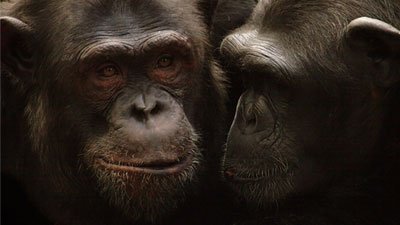
Reading Baboons
Bookish baboons said to demonstrate reading readiness pre-dated evolutionary emergence of humans.
News Source
A half-dozen happy baboons in France learned to recognize standard English words, demonstrating the biological building blocks for literacy are not unique to humans. “These biological mechanisms may be rooted much deeper in human evolutionary history than previously supposed,” write the authors of an analysis of the baboon study.1
Baboons with touch-screen computers were shown thousands of four-letter English words and some “non-words.” According to lead author Jonathan Grainger, “The first thing that comes up is a string of four letters, which at random could be a real English word or what we call a 'non-word' — a string of letters that's not a real English word.”2 They got treats whenever they punched an oval button for a real word or an “X” for a non-word. The non-words featured uncommon letter combinations. All the baboons learned to recognize at least 80 words, and clever Dan learned 308. Most interesting of all is the fact that the baboons became sufficiently familiar with common English letter combinations to score an average of almost 75% accuracy in distinguishing words from non-words they’d never seen.
The evolutionary underpinnings of reading skills have long puzzled evolutionists. Archaeological evidence of reading skills, they say, dates back “about 5,000 years ago in the Middle East.” But “reading spread across the ancient world so quickly that it cannot have required genetic changes and entirely new brain circuitry. Those don't evolve quickly enough. Instead, its rapid spread suggests that reading co-opted existing neural structures.”
Monkeys clearly lack language, so these pattern recognition skills may have evolved to help them recognize each other or objects in the environment, evolutionists suggest. “Brain circuits that evolved to serve one purpose are often ‘recycled’ in humans to support new, culturally specified functions.”3
“Brains are always looking for patterns,” Duke neuroscientist Michael Platt says. He continues,
They are always looking to make some statistical pattern analysis of the features and events that are in the environment. And this would just be one of those. . . . It's a very different way of thinking about what reading and writing really are, and it could have some implications, for example, for thinking about how we might improve education in reading and writing for young children.4
Some suggest this research has implications for literacy education and the treatment of learning disabilities, but even that contention assumes humans evolved from ape-like ancestors or had to evolve cognitive abilities along the path to true humanity. Similar neurological designs may or may not operate the same way in humans and baboons. But if they operate the same way, the cause is our Common Designer and not common ancestry.
God provided the only eyewitness account of human origins in Genesis. We know from the Old Testament that God created Adam and Eve fully human and possessing language about 6,000 years ago. The fact that pattern recognition skills are present in humans and some animals (including pigeons, which can also recognize alphabet letters) does not prove any sort of shared origin or even convergent evolution. The reason the time course for human “evolution” of sufficient braininess to read seems so short is that humans did not have to evolve those abilities at all. And because the human beings dispersed from Babel less than 4,300 years ago, as described in Genesis chapter 10, possessed language skills, we are not surprised to see archaeological evidence of reading and writing—even of multilingual word lists on clay tablets from Ebla—in ancient Middle Eastern cultures.
Further Reading
For More Information: Get Answers
Remember, if you see a news story that might merit some attention, let us know about it! (Note: if the story originates from the Associated Press, FOX News, MSNBC, the New York Times, or another major national media outlet, we will most likely have already heard about it.) And thanks to all of our readers who have submitted great news tips to us. If you didn’t catch all the latest News to Know, why not take a look to see what you’ve missed?
(Please note that links will take you directly to the source. Answers in Genesis is not responsible for content on the websites to which we refer. For more information, please see our Privacy Policy.)
Footnotes
- M. Platt and G. Adams. “Monkey See, Monkey Read.” Science 336 (2012): 168–169.
- Jon Hamilton, “The (Monkey) Business Of Recognizing Words,” NPR, April 12, 2012, http://www.npr.org/2012/04/12/150497103/the-monkey-business-of-recognizing-language.
- Platt and Adams. “Monkey See, Monkey Read.”
- Hamilton, “The (Monkey) Business Of Recognizing Words.”
Recommended Resources

Answers in Genesis is an apologetics ministry, dedicated to helping Christians defend their faith and proclaim the good news of Jesus Christ.
- Customer Service 800.778.3390
- © 2024 Answers in Genesis






